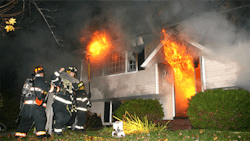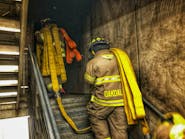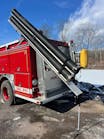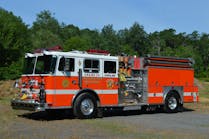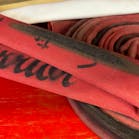The Initial Handline: Selecting the Proper Hose Diameter and Nozzle
When advancing the initial handline that will be used to make the attack on the fire, there are many considerations and decisions that must be made within seconds. Some of these considerations include what size hoseline and what type of nozzle should be used, how much hose will be needed, will a standpipe be used, and where will entrance into the building be made? The fire itself and the fire building will determine the answers to these questions.
Effective initial handline operations are one of, if not the most, important operations that occur on the fire scene. Not only does a quick and effective initial attack knock the fire down, limit further damage and prevent further hazards to firefighters, but it also provides further protection to trapped victims until search and rescue crews can reach them. The initial handline should be the first operation set into motion upon arrival on the fire scene and it should be provided with all the necessary resources to launch an effective initial fire attack.
A common phrase in the fire service is “big fire, big water.” This requires the use of the larger 2½-inch handline rather than the 1¾-inch handline. The primary factor in identifying which size hose will be needed is determining the needed fire flow. This is accomplished by using with the National Fire Academy (NFA) formula of [(length x width) / 3] x percent of involvement; or by using the Iowa formula of (length x width x height) / 100.
NFA formula example: 25-foot x 50-foot building, 25 percent involved in fire:
25’ x 50’ = 1,250 sq. ft. 1,250 / 3 = 416 416 x .25 = 104 gpm.
Iowa formula example: 25-foot x 50-foot, single-story building 10 feet high:
25’ x 50’ x 10’ = 12,500. 12,500 / 100 = 125 gpm.
Many departments also utilize guidelines for the selection and target flow rates. When utilizing guidelines, the hoseline selection is determined by the type of building that the fire is in and the target flow rate is predetermined for the hoseline that has been selected.
Also, the length of the hose stretch must be taken into consideration, when deciding what size hoseline to use. Even if the fire can be contained and extinguished using a 1¾-inch handline, if the hose stretch is going to be in excess 300 feet, a leader line set up should be utilized where a 2½-inch hoseline is utilized for the initial part of the stretch and then wyed off into a 1¾-inch handline that can be used for the fire attack.
The type of nozzle used for the fire attack will be dependent upon the resources available as not all departments may have multiple nozzles. Nozzle selection will also vary based upon department culture. Some departments prefer smoothbore nozzles while other departments prefer fog nozzles. It is important to understand how each type of nozzle works so that the correct nozzle can be selected for the operation. Smoothbore nozzles contain an open path from the coupling connection to the hoseline until the fire stream exits at the tip of the nozzle. Smoothbore nozzles operate at a nozzle pressure of 50 psi making them a great tool when operating when pressure could be limited. Smoothbore nozzles possess multiple tips of different sizes that discharge different flow rates. The flow rates for smoothbore nozzles are:
- 1¾-inch hoseline:
- 7/8-inch tip: 162 gpm
- 15/16-inch tip: 185 gpm
- 2½-inch hoseline:
- 1-inch tip: 210 gpm
- 1 1/4-inch tip: 327 gpm
- 1 1/8-inch tip: 265 gpm
Fog vs. smoothbore
Fog nozzles unlike smoothbore nozzles do not contain an open path from the coupling connection to the nozzle tip. Instead the tip of a fog nozzle possess the ability to create different stream shapes and patterns. The capability of fog nozzles to create different stream patterns rather than only a solid stream pattern like the smoothbore nozzle, requires more internal parts in a fog nozzle than in a smoothbore nozzle. These internal parts can lead to objects that travel from the water supply source through the apparatus pump and into the hoseline becoming trapped in the nozzle and restricting or completely stopping the flow of water through the nozzle. Most fog nozzles typically operate at a nozzle pressure of 100 psi.
Recently, fog nozzles have been produced that operate at lower nozzle pressures such as 75 psi and 50 psi. It is important that if these low-pressure fog nozzles are used that the hoseline is capable of reaching the target flow rate. It has been found that these low-pressure fog nozzles are not effective with all hoses. When they are used with some hoses, the friction loss in the hoseline is too high and the result is a hoseline that is not charged completely and kinks easily. Fire hose has been produced that has a friction reduction that allows for better results when using low-pressure fog nozzles.
Unlike smoothbore nozzles, there are also multiple types of fog nozzles and it is important to understand how each type of fog nozzle operates. The three types of fog nozzles are: fixed gallonage fog, selectable gallonage, and automatic.
Fixed gallonage fog nozzles provide a constant flow rate at a given nozzle pressure as well as a selectable nozzle pattern. An example of a fixed gallonage fog nozzle is the Task Force Tips Metro 1 nozzle. The nozzle is for 1¾-inch hoseline and contains multiple interchangeable discs that allow the user to set the flow rate of the nozzle at a specific nozzle pressure in advance of a fire. The interchangeable discs allow for the user to determine the nozzle pressure they would like to operate the nozzle at, choosing from the options of 100 psi, 75 psi, and 50 psi. The interchangeable discs also allow the user to determine the flow rate once the nozzle pressure has been selected, the options range from 60 gpm to 200 gpm depending on the nozzle pressure that is selected. When the fixed gallonage fog nozzle is used, the nozzle will discharge a specific flow rate if the correct nozzle pressure is provided, such as 150 gpm flow rate and 75 psi nozzle pressure.
Selectable gallonage fog nozzles allow the nozzle operator to select the flow rate of the nozzle. The flow rate of these nozzles can be changed during nozzle operation by closing the nozzle control bale, adjusting the gallonage selector to the desired flow rate, and then opening the nozzle control bale. Like a fixed gallonage fog nozzle, a selectable gallonage fog nozzle will discharge a predetermined flow rate at a specific nozzle pressure. The difference is that the nozzle operator can change the flow rate of the nozzle while the nozzle pressure remains the same. These nozzle are specifically important for foam operations as the nozzle pressure should be set to a flow rate of 95 gpm for foam operations.
Automatic fog nozzles automatically adjust the flow rate of the nozzle as the nozzle pressure changes. While the flow rate of all nozzles, regardless of type, will change as the nozzle pressure provided to the nozzle changes, the difference with an automatic fog nozzle is that the nozzle operator will not see a difference in the fire stream exiting the nozzle when an automatic fog nozzle is used. Regardless of the nozzle pressure that is provided to an automatic fog nozzle, the fire stream will look the same regardless of the nozzle pressure.
Nozzle selection for standpipe operations
While department culture will play a role in the nozzle selection decision at many fires, standpipe operations should not be one of these operations. At fires in most structures a smoothbore nozzle or fog nozzle can be used and the fire can be effectively extinguished. Standpipe operations do not fall into this category.
If a fire attack will be made from a standpipe hose outlet, a 2½-inch hoseline equipped with a smoothbore nozzle with either 1 1/8-inch or 1¼-inch tips should be used. It is imperative that automatic nozzles are not used when operating from a standpipe. Standpipe operations are pressure-sensitive operations, especially when pressure-reducing devices are present. Because of the pressure-sensitive operations, the least pressure-sensitive hoseline and nozzle setup should be selected and that setup is a 2½-inch hoseline with a smoothbore nozzle. When operating from a standpipe system, the minimum target flow rate is 250 gpm. Therefore, only the 1¼-inch tip or the 1 1/8-inch tip should be used at a flow greater than 250 gpm. The 1-inch tip flows 210 gpm, which does not meet the minimum target flow rate and therefore this nozzle tip should not be used. Fog nozzles, including low pressure, should not be used for standpipe operations as they are more prone to having a restricted or completely stopped fire stream if debris from the standpipe enters the hoseline.
Next month: Size-up determines deployment method and location.
